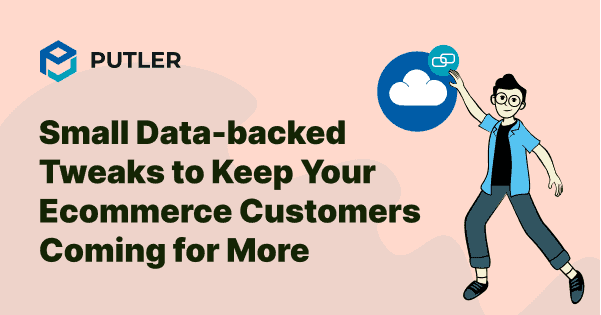Ecommerce customer expectations and demands are growing, but the landscape is getting more challenging.
Stores need to up their game to reach eyes, hearts, and wallets, but it can be difficult to understand exactly what action to take.
So, after reviewing some of the latest trends and studies, here are four data backed tweaks and changes you can employ to keep those shoppers buying more and coming back often.
Go green with products and packaging
Want to encourage higher spending and more consistent shopping from your audience? Consider going green with your products, packaging, and overall messaging. Consumers are seeking eco-friendly options in their lives and 64% of Americans are willing to pay more for sustainable products, according to GreenPrint data.
Something as simple as updating to recyclable packaging and infill can help you start promoting your green credentials. And, that same data suggests 78% of shoppers are more likely to purchase a product when it has a clear label and link to being environmentally friendly. Millennials are the most willing to spend more for a sustainable product (75%), but all consumer segments had more than half say they’d open their wallets a little wider.
Across the planet, green is selling well and projected to continue. More than 60% of people say they’ve been making more sustainable purchases since the start of the pandemic, and 90% say they’ll continue to do so going forward. Eco-friendly purchases are now a habit.
Consider offering buy now, pay later
Market uncertainty and the ongoing pandemic are changing the way people shop, and what people look for at checkout. One growing desire is “buy now, pay later” (BNPL) choice. Shopify says that BNPL purchases have grown more than 60% since the start of the pandemic, led by millennial fathers.
BNPL options are tempting for a few different reasons. First, they make larger purchases feel more reasonable and empower your audience to act on a good deal as soon as they see it. Budgeting $75 or $100 a month can feel easier to manage than trying to spend $300 to $400 all at once.
In many cases, BNPL options are interest-free if the shopper makes their payments on time, making them a preferable option over credit cards where they’d need to carry a balance. According to WiX, many BNPL payment providers will cover the risk of chargebacks and fraud.
And you may also get access to wealthier shoppers. A 2021 study found that this payment option was most popular among shoppers with an income of $100,000 to $149,000, in part because of their ability to get approved for these loans. People in higher income brackets are also more satisfied with the loan process and financing options. At the same time, you’re targeting younger consumers, about 87% of which say they would rather use installment payments than credit cards.
Ditch frustrating, expensive shipping
Free shipping discounts used to be one of the best add-ons eCommerce stores could add as a bonus for their shoppers. Now, it’s become the cost of doing business that your people expect. Two-thirds of online shoppers expect free shipping on every purchase, while 80% expect it when they reach a high dollar amount for an order, according to new data.
People want free shipping and are willing to pay for faster shipping, but demand it be easy and clear. Delays, confusion, and hidden fees send customers to other eCommerce stores. And unless you’re offering a custom product, most people shop around. Free gets them in the door and then, anything you do to reduce shipping costs goes right into improving your bottom line.
An extensive survey from Jungle Scout paints a clearer picture:
- 70% are upset when orders don’t arrive on time
- 41% expect two to three days to be the default standard shipping time
- 47% of people are willing to pay or faster shipping
- Free shipping remains the top reason people shop online, followed by convenience
Remember to keep all of this in perspective because people’s definitions change regularly. In 2022, 88% of people said they would rather wait longer than pay for shipping, but that “longer” wait time is up to seven business days. Only about one-third of your audience is willing to wait more than a week for smaller purchases.
People are now looking at shipping (during checkout and in fulfillment) to judge a company’s value, honesty, and worth of return shopping. Review your specific audience to determine the best way to respond. On average, men are more likely to pay for faster shipping, but women are more willing to wait five days or more to get their orders. Knowing your market helps you match offers to those habits, while then positioning add-ons or cost savings appropriately.
Support impulse purchases
Look for ways to improve your sales and offer more options for users to buy on the fly. This can mean improving shopping carts and sales processes or integrating with more channels that allow for direct sales, such as Instagram and Facebook. You want to be available when shoppers are ready, no matter how they find you.
The majority of today’s shoppers say they want a consistent experience across their devices when visiting your website and your social channels. Your brand should feel the same and the steps they see to see products or make a purchase should also be consistent. Some 42% of people say this is a “top expectation” of your brand and a driving reason to finalize a purchase.
One of the best ways to achieve this is to enable more campaigns and shopping across your social channels. Social shopping not only makes it easier to find you, but reports say 76% of people say it makes buying easier and 71% say they’d rather complete a purchase online than through your website.
People trust social transactions. They’re also on social media a lot more than on your website. That makes social ads and posts a great way to grab interest and transition to purchase in a few moments and even fewer clicks or taps.
Tackle customer frustrations first
Most of the eCommerce trends you’ll see in 2022 are going to focus on making shopping and fulfillment easier for customers. People are tired of confusing sites and apps, surprise fees, and supply chain delays. When you’re getting started, look for opportunities to remove headaches for your shoppers. This makes that initial purchase easier and can give you the revenue boost you may need to overhaul larger processes or core selling options.
Over to you – Try these tweaks!
So here were my top 4 simple yet effective tweaks. Do try them out and share your results in the comments section below. Incase, if you have tried something different which worked, do share them too.
- 10 Best Ecommerce Analytics Tools
- eCommerce Analytics 101: Get Answers To All Your Questions Related to Tracking your eCommerce Business
- Customer Analysis: Good Customer Insights for Better Marketing

